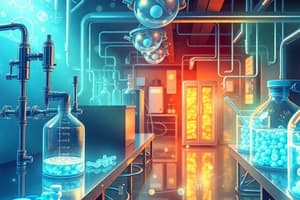Podcast
Questions and Answers
What is the primary goal of downstream processing in biomanufacturing?
What is the primary goal of downstream processing in biomanufacturing?
- To genetically modify microorganisms for enhanced product yield.
- To optimize the fermentation conditions in the bioreactor.
- To isolate, purify, and concentrate the desired product from a complex mixture. (correct)
- To maximize the growth rate of the producing organism.
Which of the following separation techniques relies on differences in boiling points to separate components?
Which of the following separation techniques relies on differences in boiling points to separate components?
- Distillation (correct)
- Centrifugation
- Filtration
- Adsorption
In downstream processing, what is the purpose of cell disruption?
In downstream processing, what is the purpose of cell disruption?
- To separate cells from the fermentation broth.
- To break open cells and release intracellular products. (correct)
- To stabilize the cell culture for long-term storage.
- To promote cell growth and increase product formation.
Why is product polishing a crucial step in downstream processing?
Why is product polishing a crucial step in downstream processing?
Which of the following methods is most suitable for concentrating a protein solution while simultaneously removing salts and small molecules?
Which of the following methods is most suitable for concentrating a protein solution while simultaneously removing salts and small molecules?
Flashcards
Downstream Processing
Downstream Processing
The series of steps needed to purify and recover biological products after fermentation or cell growth.
Purification Steps
Purification Steps
Processes involved in separating and cleaning the desired product from impurities.
Filtration
Filtration
A method used to separate solid particles from liquids or gases.
Centrifugation
Centrifugation
Signup and view all the flashcards
Lyophilization
Lyophilization
Signup and view all the flashcards
Study Notes
Downstream Processing
- Downstream processing is the series of procedures to recover useful products after fermentation or other processes.
- It's crucial for pharmaceutical, food, and other industries.
- Products may be in the cells, the medium, or both.
- Product concentrations are often low and mixed with other molecules.
Downstream Processing Steps
- Separation: Isolate desired products from mixtures.
- Cell disruption (if needed): Break open cells to release intracellular products.
- Extraction (if needed): Remove the desired product from cells or the mixture.
- Isolation: Isolate the desired product from other components.
- Purification: Further refine the product to required purity levels.
- Drying: Prepare product for handling and storage.
Downstream Processing Techniques
- Filtration: Separates solids (like bacteria, fungi) from liquids. Different methods include surface, depth, centrifugal, and rotating drum vacuum filtration.
- Centrifugation: Separates substances based on density
- Flocculation and Flotation: Used for small bacterial cells difficult to separate by other means. Flocculation aggregates cells; flotation uses gas bubbles.
- Mechanical Disruption: Breaking open cells (using shear, e.g., colloid mill, ball mill, homogenizer, or ultrasound).
- Drying: Various methods include vacuum drying, spray drying, and freeze drying.
- Extraction: Separates desired compounds from mixtures using solvents (liquid-liquid, whole broth, or multiphase aqueous methods).
- Chromatography: Used to purify molecules based on different properties. Techniques include adsorption, ion exchange, gel filtration, hydrophobic interaction, affinity, and partition.
- Evaporation/Membrane Filtration/Ion Exchange/Adsorption: Further steps in isolating and purifying substances.
Studying That Suits You
Use AI to generate personalized quizzes and flashcards to suit your learning preferences.
Related Documents
Description
Learn about downstream processing, the crucial steps to recover useful products after fermentation. It involves separation, cell disruption, extraction, isolation, purification, and drying. Various techniques like filtration and centrifugation are used.




